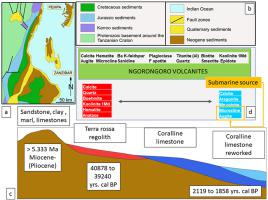Journal of African Earth Sciences ( IF 2.2 ) Pub Date : 2021-03-28 , DOI: 10.1016/j.jafrearsci.2021.104199 G. Dill Harald , A. Techmer

|
Mineral assemblages encompassing heavy (HM), light (LM) and clay minerals (CM) can be used as marker minerals for geodynamic and weathering processes. The highly diverse lithology of the Precambrian basement rocks around and the rift-related magmatic rocks of the East African Rift system (EARS) form an ideal platform to use sediment-mineralogical techniques to study the origin of the Island of Zanzibar, Tanzania, during the Quaternary. Four reference mineral associations have been defined: (1) Precambrian basement rocks (Tanzania Craton + Proterozoic rim), (2) Mesozoic rocks (magmatic rocks of the rift-and-graben system), (3) Cenozoic rocks (magmatic rocks of the rift system), (4) Quaternary placers, duricrusts and soils which form a transition zone between bedrock and the depocenter under study. Detrital grains of pyroxene and amphibole s.s.s. and autochthonous kaolinite group minerals in context with Fe-Al oxide/hydrates play a leading role for the geodynamic and geomorphological-mineralogical correlation of Zanzibar with mainland Tanzania. During the Holocene HM are likely to have been introduced into the beach sands from a magmatic submarine source and assigned Zanzibar to the marginal facies of the EARS, while a central island ridge blanketed by an argillaceous duricrust zone denotes a HM barrier towards mainland Tanzania. The difference between the mineral assemblage along the east coast of Zanzibar and the mineral assemblage of the mainland fed by the large fluvial drainage systems argues for a local magmatic HM source.
中文翻译:

东非裂谷系统(EARS)周围的重和轻标志矿物,特别涉及坦桑尼亚桑给巴尔岛的演变
包括重矿物(HM),轻矿物(LM)和粘土矿物(CM)的矿物组合可以用作地球动力学和风化过程的标志性矿物。周围的前寒武纪基底岩石的岩性和东非裂谷系统(EARS)的与裂谷有关的岩浆岩的高度多样性,为在沉积过程中使用沉积物矿物学技术研究坦桑尼亚桑给巴尔岛的起源提供了理想的平台。第四纪。定义了四个参考矿物组合:(1)前寒武纪基底岩石(坦桑尼亚克拉通+元古代边缘),(2)中生代岩石(裂谷-格拉本体系的岩浆岩),(3)新生代岩石(该岩浆岩的岩浆岩)。裂谷系统),(4)第四纪的砂土,榴ric石和土壤,形成了基岩和沉积中心之间的过渡带。辉石和闪石SS的碎屑颗粒 以及与Fe-Al氧化物/水合物共生的高岭土类矿物在桑给巴尔与坦桑尼亚大陆的地球动力学和地貌-矿物学相关性方面起着主导作用。在全新世期间,可能从岩浆海底源将HM引入了沙滩,并将桑给巴尔分配给了EARS的边缘相,而由泥质硬质岩带覆盖的中央岛屿山脊则是通往坦桑尼亚大陆的HM屏障。桑给巴尔东海岸的矿物组合与大型河流排水系统供给的大陆的矿物组合之间的差异,说明了当地的岩浆重金属来源。











































 京公网安备 11010802027423号
京公网安备 11010802027423号